ECU HONDA PASSPORT 2002 2.G Owner's Guide
[x] Cancel search | Manufacturer: HONDA, Model Year: 2002, Model line: PASSPORT, Model: HONDA PASSPORT 2002 2.GPages: 294, PDF Size: 3.97 MB
Page 196 of 294
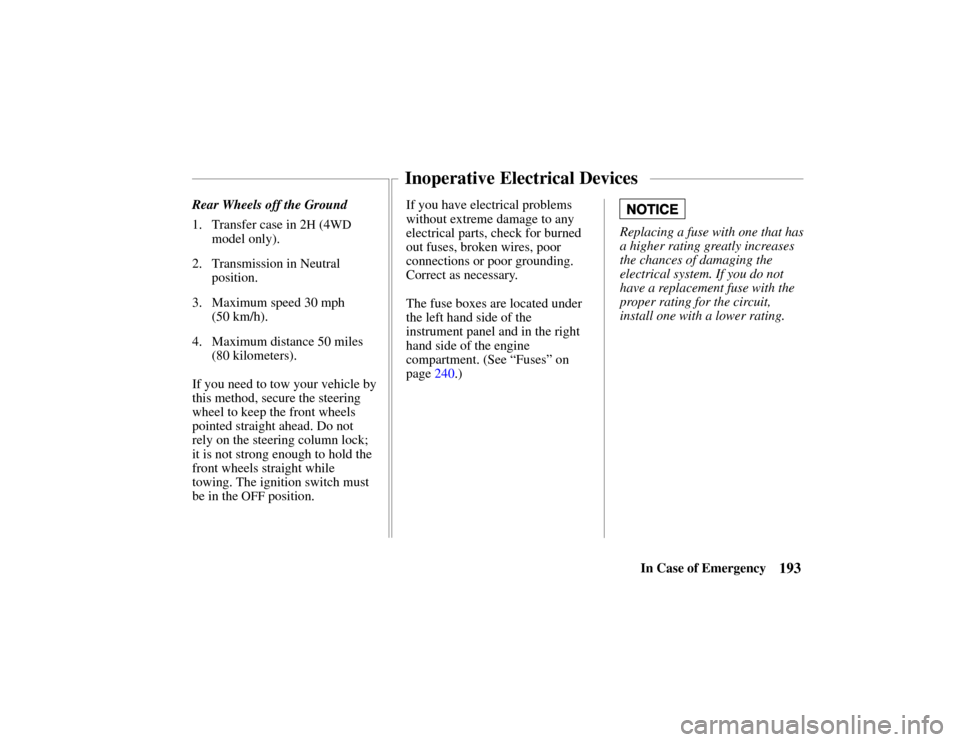
193In Case of Emergency
Rear Wheels off the Ground
1.
Transfer case in 2
H (4WD
model only).
2. Transmission in Neutral
position.
3. Maximum speed 30 mph
(50 km/h).
4. Maximum distance 50 miles
(80 kilometers).
If you need to tow your vehicle by
this method, secure the steering
wheel to keep the front wheels
pointed straight ahead. Do not
rely on the steering column lock;
it is not strong enough to hold the
front wheels straight while
towing. The ignition switch must
be in the
OFF position. If you have electrical problems
without extreme damage to any
electrical parts, check for burned
out fuses, broken wires, poor
connections or poor grounding.
Correct as necessary.
The fuse boxes are located under
the left hand side of the
instrument panel and in the right
hand side of the engine
compartment. (See
“Fuses” on
page 240.)
Replacing a fuse with one that has
a higher rating greatly increases
the chances of damaging the
electrical system. If you do not
have a replacement fuse with the
proper rating for the circuit,
install one with a lower rating.
Inoperative Electrical Devices
Page 203 of 294
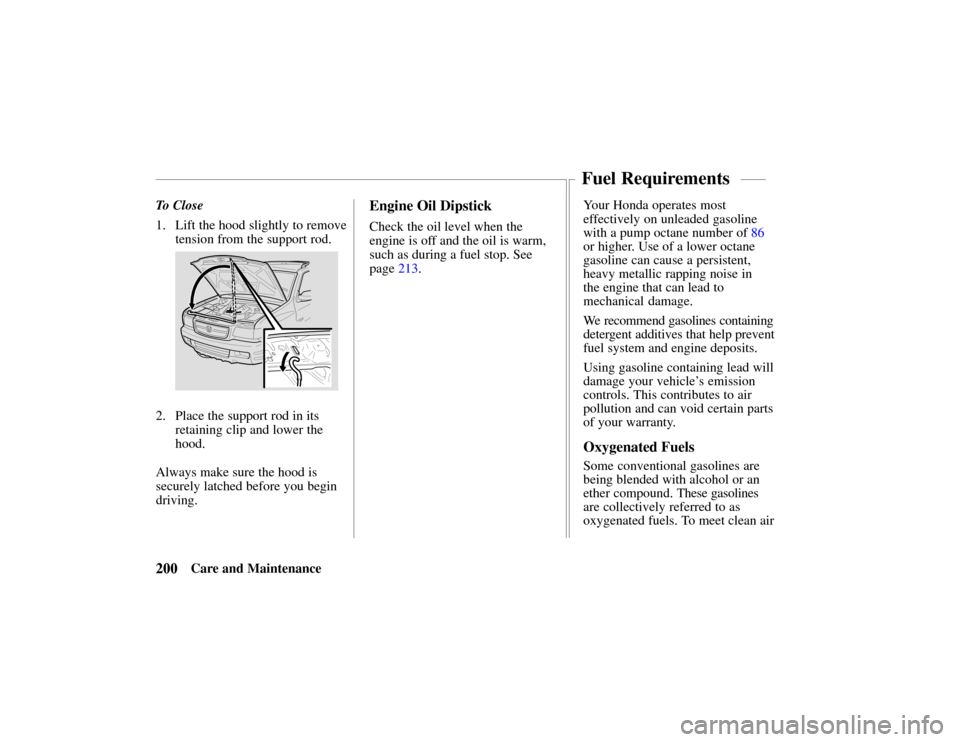
200 Care and Maintenance
To Close
1.
Lift the hood slightly to remove
tension from the support rod.
2. Place the support rod in its
retaining clip and lower the
hood.
Always make sure the hood is
securely latched before you begin
driving.
Engine Oil Dipstick
Check the oil level when the
engine is off and the oil is warm,
such as during a fuel stop. See
page 213. Your Honda operates most
effectively on unleaded gasoline
with a pump octane number of 86
or higher. Use of a lower octane
gasoline can cause a persistent,
heavy metallic rapping noise in
the engine that can lead to
mechanical damage.
We recommend gasolines containing
detergent additives that help prevent
fuel system and engine deposits.
Using gasoline containing lead will
damage your vehicle
’s emission
controls. This contributes to air
pollution and can void certain parts
of your warranty.
Oxygenated Fuels
Some conventional gasolines are
being blended with alcohol or an
ether compound. These gasolines
are collectively referred to as
oxygenated fuels. To meet clean air
Fuel Requirements
Page 212 of 294

209Care and Maintenance
Sit in the driver
’s seat and
perform these checks:
1. With the engine stopped,
depress the brake pedal several
times; the travel distance and
effective pedal stroke should
remain unchanged.
2. Start the engine with the brake pedal fully depressed.
The brake pedal should go down
a little as the engine starts.
3. Depress the brake pedal, stop the engine and hold the pedal
depressed for about 30
seconds; the brake pedal
should remain in position
without rising or going down.
4. Restart the engine and run it for about a minute, then turn it
off and depress the brake
pedal firmly several times; the
brake pedal travel should decrease each time the brake
pedal is depressed.
If the brakes do not operate
normally, have them checked and
corrected by your Honda dealer.
Exhaust system — Be alert to any
changes in the sound of the exhaust
system or any smell of fumes.
These are signs the system may be
leaking or overheating. Have the
system checked and/or repaired at
once if these conditions exist. (Also
see “Carbon Monoxide Hazard” in
the “Driver and Passenger Safety ”
section and “ Three-Way Catalytic
Converter ” in the “Driving Tips ”
section.)
Windshield wipers and
washers —
Check the operation
and condition of the wiper blades.
Check the flow and aim of the
washer spray.
Defrosters — Check performance
by moving the controls to the
defrost setting and noting the
amount of air directed against the
windshield.
Rear view mirrors and sun
visors —
Check that the friction
joints hold the mirrors and sun
visors firmly in place.
Horn — Blow the horn now and
then to be sure it works.
Lap and shoulder belts — Check
the belt system, including
webbing, buckles, latch plates,
retractors, guide loops and
anchors for proper operation and
damage.
Seat adjusters — When adjusting
a seat, be sure the seat adjusters
latch securely by pushing the seat
forward and backward.
Page 213 of 294

210Care and Maintenance
Seat-back latches — Seat-back
latches are designed to prevent
forward motion of the seat-back
when the vehicle stops suddenly.
Check to see that the seat-back
latches are holding by pulling
forward on the top of the folding
seat-back.
Also check to see that the
reclining seats are operating
properly.
Lights and beepers — Check
panel lighting, warning lights, and
the seat belt reminder light and
beeper. Also check the key beeper
and interior lights. On the outside,
check the license plate light, side
marker lights, headlights, parking
lights, taillights, brake lights, turn
signals, backup lights and hazard
warning flashers. Have the
headlight aim checked promptly if the beams seem to be aimed
improperly.
Glass — Check for broken,
scratched or damaged glass that
could reduce visibility or cause
injury.
Door latches — Check that the
doors close, latch and lock
securely.
Hood latch — Check that the
hood closes firmly. Check for
broken, damaged, or missing parts
that might prevent secure
latching. Make sure the secondary
latch keeps the hood from
opening all the way when first
released.
Fluid leaks — Check for fuel,
water, oil or other fluid leaks by
looking at the surface beneath the
vehicle after it has been parked
for awhile. Water dripping from
the air conditioning system after
use is normal. If you notice
gasoline fumes or fluid at any
time, locate the source and have it
corrected at once.
Spare tire and jack — Check that
the spare tire and all jack gear are
securely stowed at all times.
Tailgate latch — Check that the
tailgate closes, latches and locks
securely.
Page 244 of 294

Technical Data241
Fuse Box: Instrument Panel
AmperageApplicability
120AAccessory power sockets
2––––
315ACigarette lighter
415ADash/parking lights
510AInterior lights
615ABrake lights, cruise control
720APower door locks
810AMirror defoggers
915ARear window defogger
1015ARear window defogger
1115AGauges, indicators
1215ACharging system, fuel injection
1315AIgnition system
1415ATurn signals, backup lights
1515AABS, 4WD, cruise control
1620AWindshield wiper/washer
1710ARear wiper/washer
1810ASecurity & keyless entry
1915AAudio system
2020AStarter
2130APower windows, moonroof
2210ASRS
23––––
Page 273 of 294
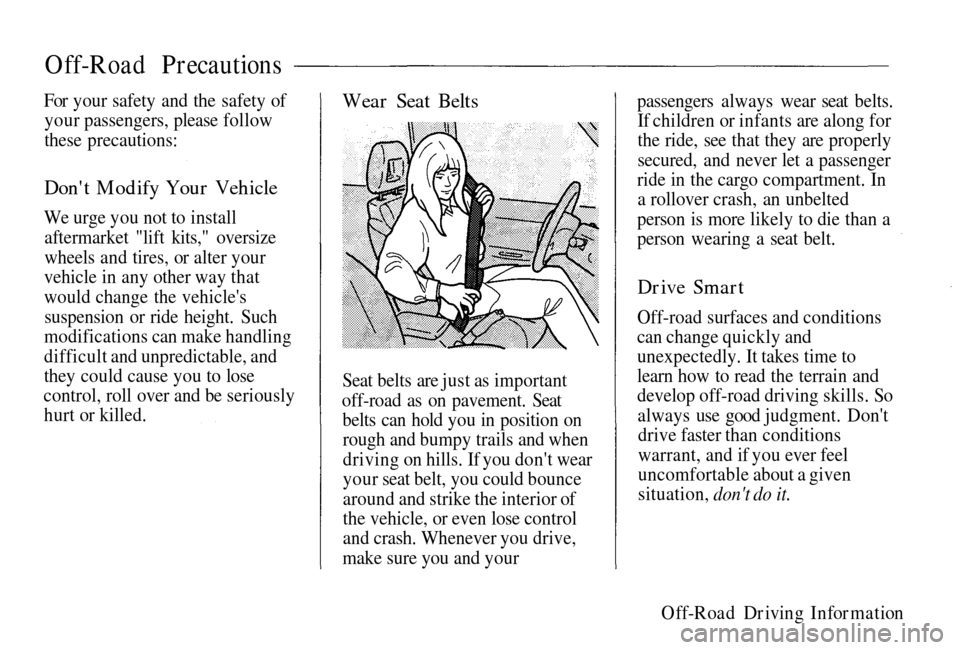
Off-Road Precautions
For your safety and the safety of your passengers, please follow
these precautions:
Don't
Modify Your Vehicle
We urge you not to install aftermarket
"lift kits," oversize
wheels and tires, or alter your
vehicle
in any other way that
would
change the vehicle's
suspension
or ride height. Such
modifications can make handling
difficult and unpredictable, and
they could cause you to lose
control, roll over and be seriously hurt
or killed. Wear Seat Belts
Seat belts are just as important
off-road as on pavement. Seat belts can hold you in position onrough
and bumpy trails and when
driving on hills. If you don't wear
your seat belt, you could bounce
around
and strike the interior of
the
vehicle, or even lose control
and crash. Whenever you drive,
make
sure you and your passengers always wear seat belts.
If
children or infants are along for
th
e ride, see that they are properly
secured,
and never let a passenger
ride in the cargo compartment. In a rollover crash, an unbelted
person
is more likely to die than a
person
wearing a seat belt.
Drive
Smart
Off-road surfaces and conditions
can change quickly and
unexpectedly.
It takes time to
learn
how to read the terrain and
develo
p off-road driving skills. So
always use good judgment. Don't drive faster than conditions
warrant,
and if you ever feel
uncomfortable about a given
situation,
don't do it. Off-Road Driving Information
Page 276 of 294
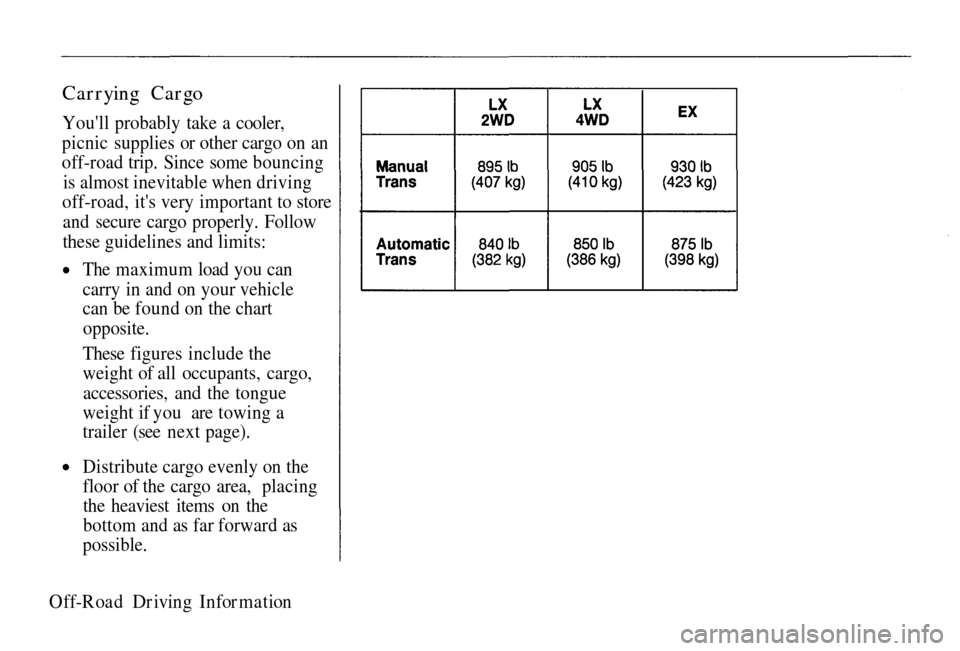
Carrying Cargo
You'll probably take a cooler,
picnic supplies or other cargo on an
off-road
trip. Since some bouncing
is almost inevitable when driving
off-road
, it's very important to store
and secure cargo
properly. Follow
these guidelines and limits:
The
maximum load you can
carry in and on your vehicle
can
be found on the chart
opposite.
These figures include the
weight of all occupants, cargo, accessories, and the tongue
weight if you are towing a
trailer (see next page).
Distribute cargo evenly on the
floor of the cargo area, placing the heaviest items on thebottom
and as far forward as
possible. Off-Road Driving Information
Page 277 of 294
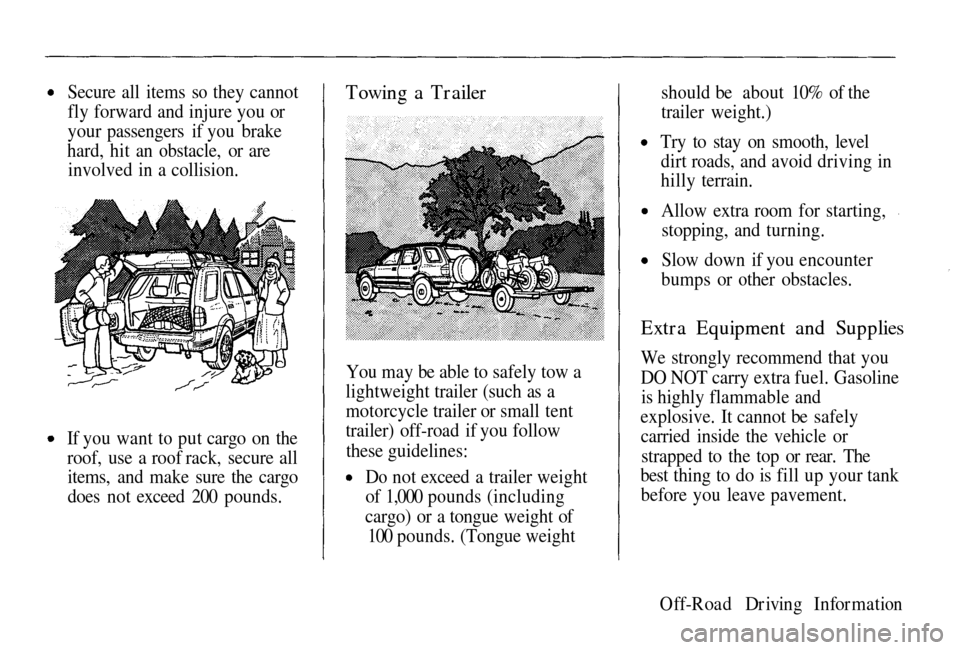
Secure all items so they cannot
fly
forward and injure you or
you
r passengers if you brake
hard,
hit an obstacle, or are
involved
in a collision.
If you want to put cargo on the
roof,
use a roof rack, secure all
items,
and make sure the cargo
does
not exceed 200 pounds. Towing a Trailer
You may be able to safely tow a
lightweight
trailer (such as a
motorcycle trailer or small tent
trailer)
off-road if you follow
these guidelines:
Do not exceed a trailer weight
of 1,000 pounds (including
cargo) or a tongue weight of 100
pounds. (Tongue weight should be about 10% of the
trailer weight.)
Try
to stay on smooth, level
dirt
roads, and avoid driving in
hilly terrain.
Allow extra room for starting,stopping,
and turning.
Slow down if you encounter
bumps
or other obstacles.
Extr
a Equipment and Supplies
We strongly recommend that you
DO NOT carry extra fuel. Gasoline is highly flammable and
explosive.
It cannot be safely
carried
inside the vehicle or
strapped to the top or rear. The
best thing to do is fill up your tank
before
you leave pavement. Off-Road Driving Information
Page 294 of 294
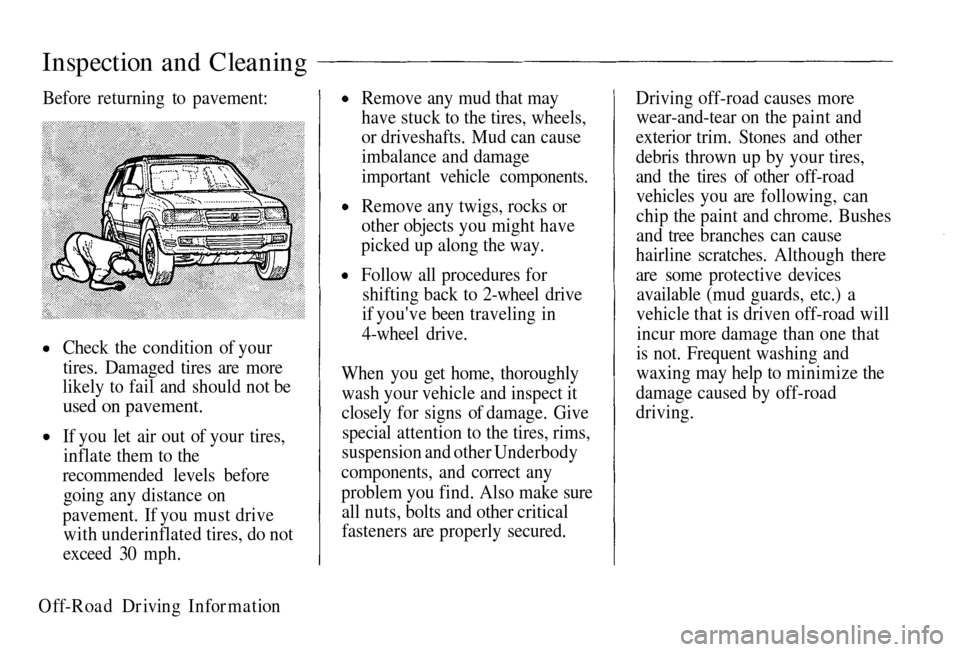
Inspection and Cleaning
Check the condition of your
tires. Damaged tires are more
likely to fail and should not be
used on pavement.
If you let air out of your tires,inflate them to the
recommended
levels before
going
any distance on
pavement.
If you must drive
wit
h underinflated tires, do not
exceed
30 mph. Remove
any mud that may
have
stuck to the tires, wheels,
or driveshafts. Mud can cause
imbalance
and damage
important vehicle components.
Remove any twigs, rocks or
other objects you might have
picked up along the way.
Follow
all procedures for
shifting back to 2-wheel drive
if you've been traveling in
4-wheel
drive.
When you get home, thoroughly wash your vehicle and inspect it
closely
for signs of damage. Give
special attention to the tires, rims,
suspension and other Underbody
components, and correct any
problem you find. Also make sure all
nuts, bolts and other critical
fasteners
are properly secured. Driving off-road causes more
wear-and-tear
on the paint and
exterior trim. Stones and other debris
thrown up by your tires,
and
the tires of other off-road
vehicles you are following, can
chip
the paint and chrome. Bushes
and tree branches can cause
hairline
scratches. Although there
are some protective devices available
(mud guards, etc.) a
vehicle that is driven off-road will
incur
more damage than one that
is not. Frequent washing and
waxing may help to minimize the
damage caused by off-road
driving.
Befor
e returning to pavement:
Off-Road Driving Information